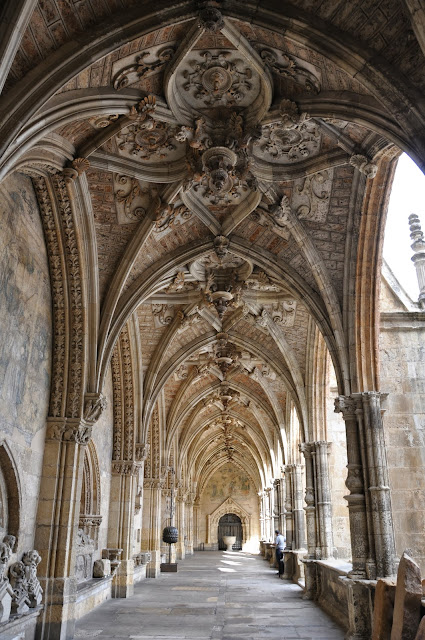One Saturday
it was raining all over Asturias and even in the closer parts of Cantabria and
Galicia and we wanted to get out of the rain. Looking at the map I realised
that Leon is just on the other side of the mountains and when we checked the
weather it promised 30 degrees and sunshine. The train ride took only two hours
from Oviedo and we had a whole day to explore this lovely city.
Not
surprisingly the coat of arms of the city is the lion and we saw its shape
everywhere in the town.
Casa Botines
I was
actually surprised to learn that one of the three buildings that Gaudí dreamt
up outside of Catalonia was here in León! I had the chance to visit the El
Capricho in Comillas (you can read about it here) and was eager to visit
another of the master architect’s buildings. Interestingly we spotted it before
we actually knew what it was. Paul said that, for him, the towers were the giveaway,
for me the wrought iron gate. When we walked around the building we realised
that we were right, we had found one of Gaudi’s early works, la Casa Botines.
The building
is unique as it was constructed in a modernist style but still kept a medieval
look. It was commissioned by a fabric merchant. The bottom floor served as a
textile warehouse and the rest of the building was used for residences.
Nowadays a bank occupies most of Casa Botines but the bottom floor is kept for cultural exhibitions. We had a quick look but the inside of the building does not have the Gaudí style.
Nowadays a bank occupies most of Casa Botines but the bottom floor is kept for cultural exhibitions. We had a quick look but the inside of the building does not have the Gaudí style.
El Catedral de León
This
cathedral was made to impress. When we stepped into the square where it stands
we were completely taken aback by its sheer size. Leon is an important stop on
the Camino Frances therefore the square was full of pilgrims on bikes and on
foot. We had a coffee while making a plan for the day on a terrace and watched
an impressive number of pilgrims having their photos taken in front of it.
During my
time in Spain I have visited quite a few cathedrals so I wouldn´t have insisted
on seeing this one except for one thing. This cathedral is very unique as it is
full of stained glass windows. There are actually 1800 square meters of glass
windows up to 12m high that go around the whole building. They were built between
the 13th and the 20th century and are believed to be some of the best in Europe.
The light
effects in the interior of the building are amazing! The sun lights up
different windows depending on the time of the day therefore it is a completely
different experience to visit it in the soft morning light or during midday in
the strong light. This is definitely the cathedral with the most sunlight in
it.
There are
other things to marvel at too, for example the gorgeous carvings or the lovely
stone sculptures. Unfortunately the organ was being tuned while we were there so
my memories are somewhat apprehensive about the visit but it was still worth
the five euro entrance fee.
The visit
does not end with the interior, however. You can visit the cloister as well and
I have never seen such a beautiful cloister before!
Roman city walls
These walls
were built in the 3rd century by the Romans in order to protect the city and
later a few kings restored them during their rule. Nowadays there are only two
sides left of them but they still give out the feeling of something very old.
Here´s a
photo we took of them. Note the motorcyclist who poses for the photo by not
holding on to his bike!
San
Marcos Monastery
This is a place with an action packed history. It was built
to be a hospital for the pilgrims of the Camino de Santiago in the 12th century. Later the Order of Santiago took charge of it, that´s where all the
scallop decoration comes from. Later the building was demolished then rebuilt
as a monastery and became one of the most impressive examples of the Spanish
Renaissance. Today it serves as the Parador of Leon. Although you have to book
a night in there to truly appreciate the luxury the chapel and the cloister is
open to visitors…most of the times but not when we were there. It still looked
amazing.
Cecina
I thought I´d throw in a little culinary note, too, for those who are interested in food.
Cecina means
cured meat but instead of cured pork which basically jamón is, it´s a different
meat, beef, horse, sometimes goat or rabbit. The most well-known is the Cecina
de León, which is meat from the hind leg of a cow, salted, smoked then dried by
air in the province of Castilla y León.
While we
were walking around the city we noticed that there´s a procession going on. We
didn´t know what was going on so I asked a family who were standing next to us
for an explanation. Apparently one of the churches nearby held a procession
for its statue of Jesus. They do this every year. Unfortunately we didn’t
understand anything else.
Some more
pictures of the city.


































































No comments:
Post a Comment